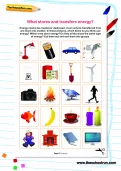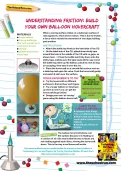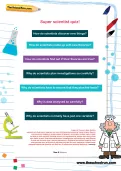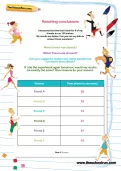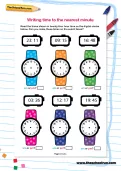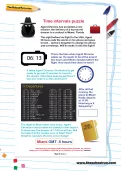A new statutory test of English grammar, punctuation and spelling was introduced for children at the end of Key Stage 2 from 2013. Help your Y6 child prepare for the 'SPAG' test with our practice papers, written in the style of the new test by a KS2 teacher.
or
Register to add to your saved resources
Already a subscriber? to view this content.
When multiplying a decimal over one (such as 2.4) by a one-digit number, the grid method can come in handy. By Y6 your child will know how to use the grid method and they will also already know how to multiply a decimal under one by a one-digit number. They just need to put these two skills together for this activity!
or
Register to add to your saved resources
Already a subscriber? to view this content.
The complete set of 2012 maths KS2 SATs papers, free to download, for the Level 6 test taken by very able children at the end of Year 6 between 2012 and 2015.
or
Register to add to your saved resources
The complete set of 2012 English KS2 SATs papers, free to download, for the Level 6 test taken by very able children at the end of Year 6 from 2012 until 2014.
or
Register to add to your saved resources
Read the times shown in twenty-four hour time on the digital clocks. Can you make these times on the watch faces?
or
Register to add to your saved resources
Prepositions show relationships between things. These could relate to time or place. Complete these sentences by using a preposition from the box below (or you could use your own). Make sure the sentence makes sense!
or
Register to add to your saved resources
Already a subscriber? to view this content.
When you want to multiply a decimal by a one-digit or two-digit number, you can use the long multiplication method. It is very important to remember to line up your numbers correctly
or your decimal point will end up in the wrong place! Practise these sums using this method.
or
Register to add to your saved resources
Already a subscriber? to view this content.
Agent Chronos has accepted a new mission: the delivery of a top-secret dossier to a contact in Miami, Florida. The night before his flight to the USA, Agent Chronos sets the alarm on his phone and goes to bed... but he’s forgotten to charge his phone and oversleeps. Will he make it onto the flight?
or
Register to add to your saved resources
Already a subscriber? to view this content.
Homonyms are pairs of words that are spelled and pronounced the same way, but have different meanings. Look at these words. Can you work out the two different meanings?
If not, look them up in the dictionary. On the next page you’ll need to create TWO crossword puzzles where the homonyms are the answers. Each word will need two different clues, one for each meaning.
or
Register to add to your saved resources
A story is either written in the past tense (if the events have already happened) or in the present tense (if the events described are happening now). Matthew has muddled his tenses in
his story. Can you correct his writing so that it is written in the past tense?
or
Register to add to your saved resources
Already a subscriber? to view this content.
The subject of a sentence is the person, place, thing or idea that is doing or being something. The verb that follows the subject changes according to whether the subject is singular or plural. Verbs also change according to whether the sentence is in the present or past tense. Can you complete this table with the correct subjects and verbs?
or
Register to add to your saved resources
Modal verbs are used to express something that is not definite. Imagine you are in charge of a picnic area. Write a notice explaining how you would like people to behave when using
the area, and why. Use as many modal verbs as you can!
or
Register to add to your saved resources
A KS2 English worksheet created by an experienced teacher to help your child identify main and subordinate clauses. Includes examples and answers.
or
Register to add to your saved resources
Already a subscriber? to view this content.
See if you can find all the irregular plural nouns for the following words hidden in this teacher-created wordsearch. You may need to look some of them up in the dictionary.
or
Register to add to your saved resources
Can you work out which numbers should go in the empty stars?
or
Register to add to your saved resources
Already a subscriber? to view this content.
A noun phrase is a group of words that act in the same way as a noun. Can you rewrite these sentences using expanded noun phrases containing adjectives, or to tell readers something about place or time? Then rewrite these sentences using expanded noun phrases that use superlatives, or that mention a person.
or
Register to add to your saved resources
Already a subscriber? to view this content.
Usually nouns have an article before them. Look at these paragraphs. Underline all the definite articles in blue and all the indefinite articles in red.
or
Register to add to your saved resources
Already a subscriber? to view this content.
When we talk about clauses in a sentence, we mean their parts. Clauses always have a noun and a verb in them and are often linked by a connective. These sentences each have two clauses with a comma or connective between them. Underline each of the separate clauses.
or
Register to add to your saved resources
The volume of a cube / cuboid = length x height x width. Look at the following shape pairs and estimate which has the bigger volume. Work out the volume with the formula; were you right?
or
Register to add to your saved resources
Already a subscriber? to view this content.
If a number sentence has brackets in it, you need to do the operation in brackets first. Work out the following, remembering to do the operations in brackets first (some of these have negative answers!).
or
Register to add to your saved resources
Already a subscriber? to view this content.
